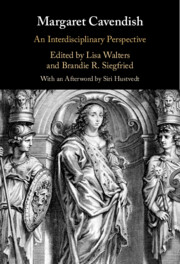Book contents
- Margaret Cavendish
- Margaret Cavendish
- Copyright page
- Contents
- Illustrations
- Notes on Contributors
- In Memoriam
- Acknowledgments
- Introduction
- Part I History of Science
- Part II Philosophy
- Part III Literature
- Part IV Politics
- Part V New Directions
- Chapter Fifteen Close Reading (and) Textual Bibliography
- Chapter Sixteen Companions, Competitors, Contexts
- Chapter Seventeen Cavendish Studies and the Digital Turn
- Afterword
- Chronology of Works by Margaret Cavendish
- Select Bibliography
- Index
Chapter Sixteen - Companions, Competitors, Contexts
Margaret Cavendish in Women Writers Online
from Part V - New Directions
Published online by Cambridge University Press: 28 April 2022
- Margaret Cavendish
- Margaret Cavendish
- Copyright page
- Contents
- Illustrations
- Notes on Contributors
- In Memoriam
- Acknowledgments
- Introduction
- Part I History of Science
- Part II Philosophy
- Part III Literature
- Part IV Politics
- Part V New Directions
- Chapter Fifteen Close Reading (and) Textual Bibliography
- Chapter Sixteen Companions, Competitors, Contexts
- Chapter Seventeen Cavendish Studies and the Digital Turn
- Afterword
- Chronology of Works by Margaret Cavendish
- Select Bibliography
- Index
Summary
WWO collects approximately 430 pre-Victorian works by women, marked up according to the Text Encoding Initiative Guidelines. WWO markup identifies features such as named entities, quotations and textual references, and the structures of verse, prose, and drama. WWO thus enables comparison of many aspects of Cavendish’s work – including typography, language use, and citation practices – with other well-represented authors, with other seventeenth-century writers, and with the corpus as a whole. Text encoding shows where Cavendish’s practices are similar to her contemporaries’ – she uses Latin, French, and Italian in comparable proportions to other seventeenth-century authors – as well as where they are different. For example, there are more than 5,000 textual titles referenced in WWO but Cavendish is unique for naming titles in cast lists, all references to her own works. Cavendish’s distinctiveness has been the subject of much discussion since her own day; as this chapter will show, markup makes it possible to interrogate claims of her singularity by examining the many textual features formalized through encoding.
Keywords
- Type
- Chapter
- Information
- Margaret CavendishAn Interdisciplinary Perspective, pp. 248 - 260Publisher: Cambridge University PressPrint publication year: 2022

